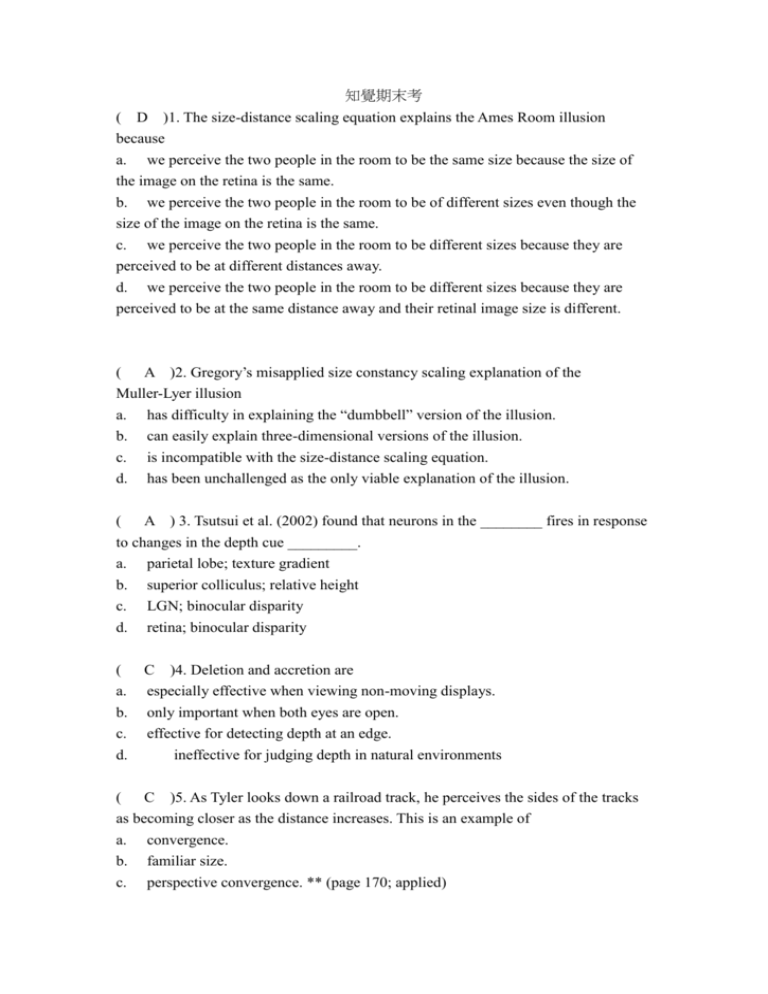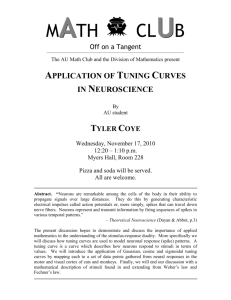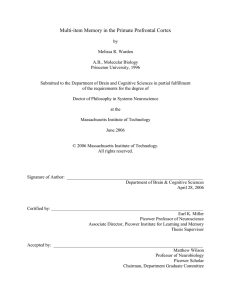知覺期末考
advertisement

知覺期末考 ( D )1. The size-distance scaling equation explains the Ames Room illusion because a. we perceive the two people in the room to be the same size because the size of the image on the retina is the same. b. we perceive the two people in the room to be of different sizes even though the size of the image on the retina is the same. c. we perceive the two people in the room to be different sizes because they are perceived to be at different distances away. d. we perceive the two people in the room to be different sizes because they are perceived to be at the same distance away and their retinal image size is different. ( A )2. Gregory’s misapplied size constancy scaling explanation of the Muller-Lyer illusion a. has difficulty in explaining the “dumbbell” version of the illusion. b. can easily explain three-dimensional versions of the illusion. c. is incompatible with the size-distance scaling equation. d. has been unchallenged as the only viable explanation of the illusion. ( A ) 3. Tsutsui et al. (2002) found that neurons in the ________ fires in response to changes in the depth cue _________. a. parietal lobe; texture gradient b. superior colliculus; relative height c. LGN; binocular disparity d. retina; binocular disparity ( a. b. C )4. Deletion and accretion are especially effective when viewing non-moving displays. only important when both eyes are open. c. d. effective for detecting depth at an edge. ineffective for judging depth in natural environments ( C )5. As Tyler looks down a railroad track, he perceives the sides of the tracks as becoming closer as the distance increases. This is an example of a. convergence. b. familiar size. c. perspective convergence. ** (page 170; applied) d. motion parallax. ( D )6. What depth cue could be classified as a binocular cue and an oculomotor cue? a. accommodation b. accretion c. stereopsis d. convergence ( a. D )7. Movies: _______ :: Waterfall illusion: _____________. apparent movement; induced movement b. c. d. real movement; apparent movement movement aftereffects; stroboscopic movement apparent movement; movement aftereffects ( B )8. Simone looks at the moon and some clouds at night. She perceives the moon moving through the clouds. This is an example of a. the stroboscopic effect. b. induced motion. c. the Reichardt effect. d. the Shedlock effect. ( C )9. When a wire cube or any other 3-D wire figure is rotated and projected as a 2D shadow, the shadow is perceived as 3D. This is called the _________ effect. a. shortest-path b. framework c. kinetic depth d. biological depth ( D )10. Percy is injected with a drug that paralyzes his eye muscles. When he is instructed to try to move his eye when looking a stationary scene, he perceives a. no movement, because his eye muscles can’t move. b. no movement, because the scene is stationary. c. movement, because there is a CDS and an IMS. d. movement, because there is a CDS, but not an IMS. ( A )11. The two kinds of stimuli most often used to study the neural response to movement are a. moving bars and moving dots. ** (page 204; factual) b. c. d. moving triangles and moving squares. moving circles and stationary circles. moving animal shapes and geons. ( B )12. The aperture problem is solved by the pooling of responses of a number of V1 neurons. Physiological evidence suggests that this pooling occurs in the ____, a nucleus in the _____stream. a. MT cortex; ventral b. MT cortex; dorsal c. PF cortex; “what” d. PF cortex; “how” ( A )13. Kourtzi and Kanwisher (2000) used fMRI’s to show that “implied motion” stimuli cause a. greater responses in the MT and MST than “non-implied motion” stimuli. b. greater responses in the MT and sonetimes responses in non-implied motion” stimuli. c. greater responses in the MST than MT and non-implied motion” stimuli. d. greater responses in the MT than MST and non-implied motion” stimuli. ( C )14.Mirror neurons in the monkey fire a. when the monkey want to eat the food and eating the food. b. when the experimenter grasps the food with his/her fingers, and when the experimenter picks up the food using pliers. c. when the monkey sees the experimenter grasp a piece of food, and when the monkey also grasps the food. d. when the monkey eat the food, and when the monkey picks up the food using pliers. ( A )15.Calton et al. (2002) gave monkeys a cue signaling the appearance of an object the monkey was trained to grasp. They found neurons in the parietal lobe that respond a. after the cue appears, but before the object actually appears. b. before a cue appears and after the object to-be-grasped appears. c. before actually grasping the object, after the object to-be-grasped appears. d. after grasping the object, but before the manipulating the object. ( D )16._______ neurons respond well when looking at a button in the light or pushing a button in the light, but does not respond to pushing the button in the dark. a. Olfactory neurons b. Motor-dominant c. Visual-mirror neurons d. Visual-dominant ( B )17. Rinds & Simmons, 1999 對鴿子做撞擊的神經元檢驗,發現神經元會 在何時反應? A. 撞倒牆壁的同時 B. 撞倒牆壁的前一秒 C. D. 看到牆壁時 感覺到痛時 ( a. b. c. d. C )18. MST neurons that respond to flow tend not to be motion-selective. are found in the ventral stream. can be selective to motion expanding outward or circular motions. have not been found in the monkey brain. ( D )19. According to Land and Lee, drivers negotiate curves by a. b. c. d. keeping the FOE invariant. looking directly at the road. using multiple affordances. use information in addition to optic flow ( a. b. c. B )20. The cochlear implant makes use of phase locking mechanisms in the sound processor. the tonotopic map of frequencies on the cochlea. artificial ossicles. d. resonance harmonics on the tectorial membrane ( D )21. Periodicity pitch is _________ if two tones are presented to different ears, suggesting that pitch is processed ___________. a. not perceived; in the cochlea b. not perceived; in the superior olivary nucleus c. perceived; in the cochlea d. perceived; cortically ( A )22. The auditory cortex is similar to the visual cortex in that a. both have a “core” processing area, and areas outside the core process more complex stimuli. b. both receive input from the superior colliculus. c. phase locking is important for both. d. none of these; there are no major similarities. ( B )23.The outer hair cells respond to sound by slightly tilting and changing length. This is a. the tuning response. b. c. d. the motile response. phase locking. the traveling wave. ( a. b. c. d. A )24.The masking effect shown by Egan and Hake doesn't demonstrated that the masking effect spreads more to low frequencies than high frequencies. the masking effect spreads more to high frequencies than low frequencies. the masking effect is asymmetrical. the masking effect can spread to other noise. ( D )25.Bekesy’s place theory of hearing proposes that the frequency of a sound is a. based on how much the inner hair cells are bent. b. based on how much the outer hair cells are bent. c. based on whether the sound is processed through the round window or the oval window. d. the place along the organ of Corti at which the nerve firing is highest ( C )26.下列哪一個不是 place theory 的證據 a. b. c. base 比 apex 的硬度來的硬 Bekesy’s theory 認為不同音高在 Basilar membrane 有不同波峰 不同高音可同時由不同區域共同反應 d. tonotopic map ( a. b. B )27. Adding a 440 Hz tone to a 880 Hz tone and a 1320 Hz tone will result in a black noise. a complex tone. c. a “hissing”sound. d. a white noise. ( a. b. c. d. A )28. Humans can localize sounds most accurately when the sound is directly in front of them. ** (page 266; factual) when the sound is directly behind them. when the sound is off on the left side if the person is right-handed. when the sound is off on the left side if the person is left-handed ( a. A )29. Interaural level differences are a cue to auditory localization because the person’s head creates an acoustic shadow that prevents high-frequency sounds from reaching the far ear. b. person’s head creates an acoustic shadow that prevents low-frequency sounds from reaching the far ear. c. d. medium through which the sound travels can be air, liquid, or solid. acoustic shadow is more likely to occur in an enclosed space than outdoors. ( B )30. The difference between the sound from the source and the sound actually entering the ears is called the a. non-spectral reverberation effect. b. head-related transfer function. c. d. interaural shadow. pseudo-polyphonic function. ( B )31.ITD 和 ILD 不同的地方在於 a. 前者定位左右聲音,後者定位前後聲音 b. 前者定位低音,後者定位高音 C. 前者定位前後聲音,後者定位左右聲音 D. 前者定位高音,後者定位低音 ( a. b. c. d. C )32. Garner & Garner 用耳塞做的實驗是為了證明哪一件事? 戴上耳塞能可聽的到聲音 戴上耳塞後就無法辨認聲音來源 戴上耳塞能可辨認前後聲音 戴上耳塞習慣後能可辨認聲音 ( A )33. Neurons in the nonprimary auditory cortex that fire to sounds coming from a number of different directions are called a. panoramic neurons. b. c. d. MLD cells. virtual space cells. K cells. ( a. b. c. d. C )34. Vision: figure-ground segregation :: Audition: ________________. the ecological approach intimacy auditiory scene analysis Fourier analysis ( B )35. Melodic channeling, or the scale illusion, is based on the auditory grouping law ________. a. location of pitch b. c. d. similarity of pitch onset of pitch offset of pitch ( a. b. D )36. In the precedence effect, the sound from the far speaker does not contribute to the perception of the sound. only helps sound localization if the time difference is less than 5 milliseconds. c. d. only helps sound localization if the time difference is less than 2 milliseconds. contributes to the richness of the sound ( A )37. A sound spectrogram is a plot of ______________ as a function of _____________, with darker areas representing greater intensity. a. frequency; time b. amplitude; frequency c. time; amplitude d. time; spatial location of sound source ( a. b. c. d. B )38. Listening to someone speak a foreign language is used as an example of the correspondence problem. the segmentation problem. the formant transition effect. acoustic signaling. ( C )39. The existence of phonetic boundaries a. is currently debated by speech perception researchers. b. c. d. only occurs at VOTs of greater than 250 ms has been demonstrated using discrimination experiments. shows that categorical perception does not occur in speech perception. ( B )40. Brain scanning research has shown that areas in the ________are selectively activated by the human voice. a. “where” stream b. “what” stream c. corpus callosum d. pacinian area










